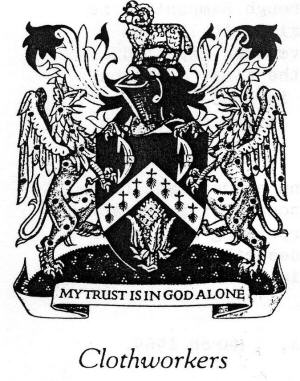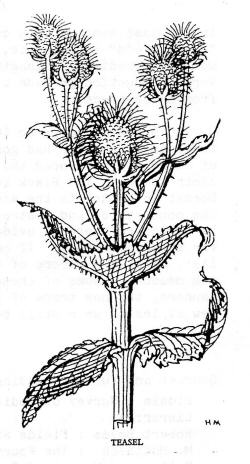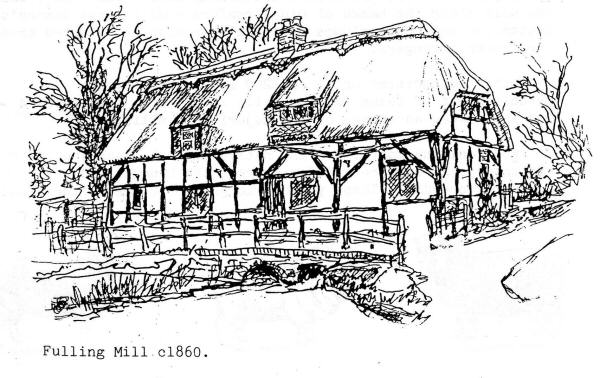No. 103 FULLING IN ALRESFORD.
by John Adams.

One of the 12 Greater Livery Companies banners.
During the decade leading up to 1985 a devoted team under Professor Martin Biddle worked to produce a brilliant piece of scholarship called The Survey of Medieval Winchester.
These studies are available to the general public through the lending libraries. Anyone who feels inspired to borrow this work may appreciate a word of warning : take a trolley to collect it, have a large clear table available to study it for the maps and enclosures require spreading out and give yourself plenty of time to enjoy them.
 Of course, this work
is all about Winchester
but by a great bit
of luck it refers to
an aspect of Alresford
which has been preserved
through the ages. On
page 306 or Volume
2 one reads
"the earliest fulling
mills recorded in the
Winchester district were
operating at New Alresford
Bishop's Sutton and Bishop's
Waltham by 1209 This
episcopal enterprise
(by which is meant 'scheme
of the bishops, I suppose!)
with what was still a
recent technological
innovation was matched
within 15 years by the
citizens of Winchester
at Prior's Barton".
Of course, this work
is all about Winchester
but by a great bit
of luck it refers to
an aspect of Alresford
which has been preserved
through the ages. On
page 306 or Volume
2 one reads
"the earliest fulling
mills recorded in the
Winchester district were
operating at New Alresford
Bishop's Sutton and Bishop's
Waltham by 1209 This
episcopal enterprise
(by which is meant 'scheme
of the bishops, I suppose!)
with what was still a
recent technological
innovation was matched
within 15 years by the
citizens of Winchester
at Prior's Barton".
Note the date: 1209. Alresford's founder,Godfrey de Lucy was dead but his successor, Peter de la Roche was an equally sound business man. Godfrey with his weir and channelled water had made the scheme possible Bishop Peter had carried it out.
But where? I would like to claim that it is where our fulling mill is today and call attention to it before some authority gives permission for its conversion into something quite different! 1 have no evidence except XIIIth century on the south wall.
Let us imagine that the fulling mill is the site. A steady flow of clean water, well made channels in which the cloth can be trodden by foot or pounded by mill rams : wide open spaces where the cloth can be stretched or dried on the tenterhook frames, and an increased flow beyond the mill so that the dirty liquid can be flushed away and the process of self-purification of a stream can start.
I am running ahead a little. What is fulling? The fuller's trade included washing, cleaning, shrinking and beating the cloth in order to thicken it. The process was performed in flowing water by men's feet tramping soap and fuller's earth, which covered the cloth : later men's feet were replaced by a pounding mill. The term "fulling" gradually went out of use in the wake of the larger process of ''milling'' although the description "fulling rollers" is still in use today.
After the cloth had been fulled, the fuller stretched it out on racks to dry, then raised the nap with teazel heads and trimmed the surface of the cloth to a velvety finish with the massive fuller's shears. The actual spinning of the cloth by spinsters, would have formed a very useful cottage industry in the area. De Lucy, of course, was a very discerning man. Even today, when you walk along the banks or 01d Alresford Pond towards Bishop's Sutton you come upon clumps of teazels growing undisturbed except for flower arrangers.
Other authorities write of 1290 as the date of the establishment or these fulling malls in Britain, so Alresford had an 80 year advantage on the majority of mills.

For wool the most important native English sheep are the Down (Southdown, Shropshire and Hampshire),the Lincoln and the Leicester breeds. These yield a longer and coarser fibre, and in the last century were crossed with the Merino stock giving "cross-breeds" Corriedale Polwarth etc), with a relatively fine Wool intermediate in length between medium and long wool breeds. World production is made up of about a third from Merinos and a half from cross-breds.

The Survey goes on to tell us that by the XVth century, the cloth trade in Winchester had gone into decline and the towns north west of Salisbury developed the very successful Cotswold and South West cloth trade. The Black Death, as is well known, swept up from Dorset to London in the middle of the XIVth century, depopulating the countryside and destroying our native industries. But for us in Alresford there is evidence that the trade hung on in a small way for another century. If one reads Robert Boyes' Fields as they lie' here is a record or the stretching frames still in use in the meadows. Some of these of course, must have been used by the tanners, the new trade of Alresford but it is nice to think that a few at least were still being used by the fullers.
John Adams, October 1994.
Sources and further reading:
Biddle : Survey of Medieval Winchester : 1985 : Hampshire
Libraries.
Robert Boyes : Fields as they lie : H.R.O.
H. McKiseck : The Fourteenth Century : 1959 : O.U.P.
Kelley : Museum or Science and Industry, Leeds.
Society for the Preservation of Ancient Buildings
Fulling Mills, Paper Number 5.
The writer acknowledges with gratitude the lessons learnt and the information gained from the late Digby Grist on our walks together.